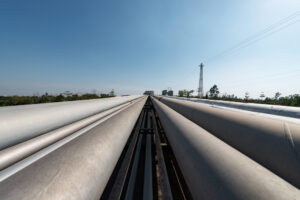Altamira’s Technical Experts Published in the Journal of Pipeline Science and Engineering

Altamira’s Zhenjin Zhu and TK Akins and their co-authors Steve Cooper and Brian Cooper’s paper “A Simplified Predictive Model of Thermal Cycling on Initiation of Stress Corrosion Cracking” was recently published in the Journal of Pipeline Science and Engineering. The paper explores how thermal cycling contributes to the development of corrosive environments and the initiation of stress corrosion cracking (SCC) on the external surface of steel pipelines.
ABSTRACT
This paper develops a simplified predictive model to investigate the role of thermal cycling in the evolution of a corrosive environment for the initiation of stress corrosion cracking (SCC) on the external surface of steel pipelines. Prior to commissioning, coatings may be disbonded in places due to improper material selection or poor application. Corrosive gases (i.e., O2, CO2) and water vapor diffuse into coating disbondment areas from the soil side. The diffused amount of each species is obtained by solving Fick’s First Law. The accumulation of condensed water vapor depends on the solubility change of water vapor with respect to thermal cycling frequency and magnitude. The concentrations of [H+], [HCO3-], and [CO32-] are dependent on CO2 partial pressure. The metal surface potential is predicted using a resistance circuit model. When an open coating holiday occurs, the cathodic protection (CP) current arrives at the metal surface directly through the exposed electrolyte. The local surface potentials inside the crevice are simulated using a parametric equation. The pH value at an open holiday obeys Faraday’s Second Law of Electrolysis. Local tensile stress may come from hoop stress from design, residual stress from manufacturing and fabrication, thermal stress from operation, geotechnical stress from soil movement, and mechanical stress from deformation. When the pH value, surface potential, and tensile stress are within certain bounds, stress corrosion cracking may take place longitudinally or circumferentially depending on stress orientation. Types of SCC such as high-pH SCC or near-neutral pH SCC can be characterized. The model was qualitatively validated through comparing the predicted results with the field measurements published by authoritative industry literatures. The findings should be useful for stakeholders in proactively developing preventive and mitigative measures for effective SCC threat management.

To learn more about Altamira, contact us at info@altamira-us.com.

Meet the Authors
 TK Akins
TK Akins
Vice President, Integrity
TK steers our asset integrity division, skillfully blending program management with technical acumen to safeguard our clients’ assets and catalyze growth across their initiatives. With over 15 years of industry experience, TK specializes in the strategic expansion of consulting services and the management of integrity, demonstrating a steadfast commitment to excellence and innovation in every project undertaken.
TK can be reached at tk.akins@altamira-us.com
 Zhenjin Zhu, Ph.D., P.Eng.
Zhenjin Zhu, Ph.D., P.Eng.
Principal Engineer
Zhenjin can be reached at Zhenjin.zhu@altamira-us.com



